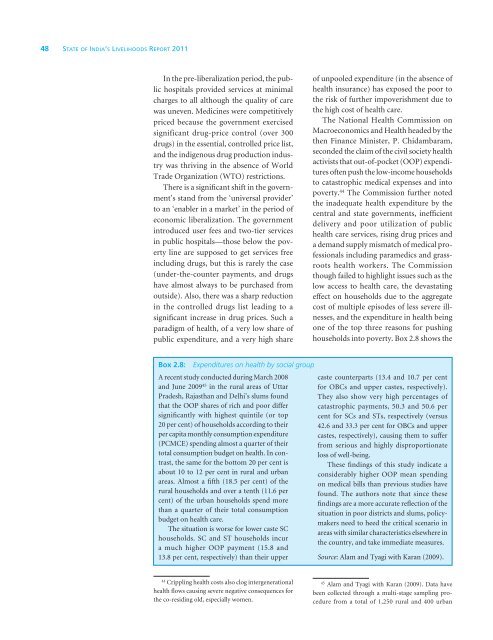SOIL Report 2011 - ACCESS Development Services
SOIL Report 2011 - ACCESS Development Services
SOIL Report 2011 - ACCESS Development Services
- No tags were found...
You also want an ePaper? Increase the reach of your titles
YUMPU automatically turns print PDFs into web optimized ePapers that Google loves.
48 State of India’s Livelihoods <strong>Report</strong> <strong>2011</strong>In the pre-liberalization period, the publichospitals provided services at minimalcharges to all although the quality of carewas uneven. Medicines were competitivelypriced because the government exercisedsignificant drug-price control (over 300drugs) in the essential, controlled price list,and the indigenous drug production industrywas thriving in the absence of WorldTrade Organization (WTO) restrictions.There is a significant shift in the government’sstand from the ‘universal provider’to an ‘enabler in a market’ in the period ofeconomic liberalization. The governmentintroduced user fees and two-tier servicesin public hospitals—those below the povertyline are supposed to get services freeincluding drugs, but this is rarely the case(under-the-counter payments, and drugshave almost always to be purchased fromoutside). Also, there was a sharp reductionin the controlled drugs list leading to asignificant increase in drug prices. Such aparadigm of health, of a very low share ofpublic expenditure, and a very high shareof unpooled expenditure (in the absence ofhealth insurance) has exposed the poor tothe risk of further impoverishment due tothe high cost of health care.The National Health Commission onMacroeconomics and Health headed by thethen Finance Minister, P. Chidambaram,seconded the claim of the civil society healthactivists that out-of-pocket (OOP) expendituresoften push the low-income householdsto catastrophic medical expenses and intopoverty. 44 The Commission further notedthe inadequate health expenditure by thecentral and state governments, inefficientdelivery and poor utilization of publichealth care services, rising drug prices anda demand supply mismatch of medical professionalsincluding paramedics and grassrootshealth workers. The Commissionthough failed to highlight issues such as thelow access to health care, the devastatingeffect on households due to the aggregatecost of multiple episodes of less severe illnesses,and the expenditure in health beingone of the top three reasons for pushinghouseholds into poverty. Box 2.8 shows theBox 2.8: Expenditures on health by social groupA recent study conducted during March 2008and June 2009 45 in the rural areas of UttarPradesh, Rajasthan and Delhi’s slums foundthat the OOP shares of rich and poor differsignificantly with highest quintile (or top20 per cent) of households according to theirper capita monthly consumption expenditure(PCMCE) spending almost a quarter of theirtotal consumption budget on health. In contrast,the same for the bottom 20 per cent isabout 10 to 12 per cent in rural and urbanareas. Almost a fifth (18.5 per cent) of therural households and over a tenth (11.6 percent) of the urban households spend morethan a quarter of their total consumptionbudget on health care.The situation is worse for lower caste SChouseholds. SC and ST households incura much higher OOP payment (15.8 and13.8 per cent, respectively) than their uppercaste counterparts (13.4 and 10.7 per centfor OBCs and upper castes, respectively).They also show very high percentages ofcatastrophic payments, 50.3 and 50.6 percent for SCs and STs, respectively (versus42.6 and 33.3 per cent for OBCs and uppercastes, respectively), causing them to sufferfrom serious and highly disproportionateloss of well-being.These findings of this study indicate aconsiderably higher OOP mean spendingon medical bills than previous studies havefound. The authors note that since thesefindings are a more accurate reflection of thesituation in poor districts and slums, policymakersneed to heed the critical scenario inareas with similar characteristics elsewhere inthe country, and take immediate measures.Source: Alam and Tyagi with Karan (2009).44Crippling health costs also clog intergenerationalhealth flows causing severe negative consequences forthe co-residing old, especially women.45Alam and Tyagi with Karan (2009). Data havebeen collected through a multi-stage sampling procedurefrom a total of 1,250 rural and 400 urban














